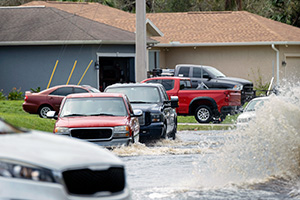Flood-Damaged Cars: How to Spot & Avoid Them
 While flood-damaged cars may seem unaffected at first glance, they can pose significant risks for unsuspecting buyers. According to the National Automobile Dealer's Association (NADA), it's not uncommon for dishonest sellers to refurbish, perform superficial repairs, or alter titles of flood-damaged cars and resell them, only for mechanical and electrical issues to surface once the seller is long gone.
While flood-damaged cars may seem unaffected at first glance, they can pose significant risks for unsuspecting buyers. According to the National Automobile Dealer's Association (NADA), it's not uncommon for dishonest sellers to refurbish, perform superficial repairs, or alter titles of flood-damaged cars and resell them, only for mechanical and electrical issues to surface once the seller is long gone.
How To Tell if a Car Was in a Flood
Weird Odors
Flood-damaged cars often have lingering odors due to prolonged water and contaminant exposure. These musty odors might originate from soaked upholstery, carpets, ventilation systems, or even mold growth in hidden crevices that the seller may not have been able to clean adequately. Be wary of cars with strong cleaning solution smells or air fresheners and always run the air conditioner to check for moldy odors.
Discolored Interior
A discolored interior can be a telltale sign of a flood-damaged car. This can look like stains or water lines on upholstery, carpets, and door panels. If a used car has new upholstery, carpet, seatbelts, or trim pieces, it’s possible the seller is trying to conceal water damage.
Sand and Dirt in Places
The presence of sand and dirt in unexpected places may indicate flood damage, as floodwaters can carry sediments into even the smallest cracks and crevices. Be suspicious of any dirt or sand lodged in carpets, engine bays, glove compartments, and hard-to-reach places
Rust and Moisture
Rust and moisture are common indicators of flood damage in cars, particularly in the undercarriage, engine bay, dashboard, and door frames. Buyers should pay close attention to signs of corrosion, including bubbled paint or flaking metal, as they suggest prolonged exposure to water. Condensation or fogging of exterior lights may also be a warning sign.
Smoke and Odd Noises Inside the Engine
Smoke and odd noises coming from the engine bay may indicate a flood-damaged vehicle. Floodwaters can infiltrate critical engine components, causing corrosion, electrical shorts, and mechanical failures over time, made evident by smoke. Buyers should be wary if they notice smoke during startup or operation.
Odd noises such as knocking, grinding, or squealing could also indicate water damage to engine parts, such as bearings or pistons, which may compromise the vehicle's reliability and longevity.
Broken Electronics
Broken electronics are a common red flag indicating flood damage in a vehicle. Floodwaters can infiltrate sensitive electronic components, causing short circuits, corrosion, and malfunction. Buyers should be cautious if they encounter intermittent or sudden issues with the car's infotainment system, audio system, dashboard controls, or power windows and locks, as these are often the first areas affected by water damage
How can I check a car's history for flood damage?
One of the most reliable methods of checking a car’s history for flood damage is to obtain a vehicle history report from reputable sources AutoCheck. These reports compile information from various sources, including insurance claims, salvage yards, and state DMV records, providing a comprehensive overview of the car's past. Buyers should scrutinize the report for any indications of flood damage, such as salvage titles, insurance claims related to flooding, or multiple registrations in flood-prone areas.
Can you fix a flood-damaged car?
Whether a flood-damaged car can be fixed largely depends on the extent of the damage. In cases of minor damage, such as minimal water exposure without significant infiltration into critical components, repairs may be feasible. This typically involves thorough cleaning, drying out the interior, replacing damaged upholstery or electronics, and addressing any corrosion or rust that may have developed. Even with minor damage, it's essential to conduct a comprehensive inspection to ensure that all affected areas are properly addressed to prevent future issues.
If the flood damage is extensive, such as water reaching the engine, transmission, or electrical systems, repairs may be significantly more challenging and costly. In such cases, the cost of repairs may exceed the value of the car, making it economically unfeasible to fix. It’s also important to note that flood damage can compromise the structural integrity of the vehicle, posing safety risks even after repairs. In these situations, it may be more practical for the car to be declared a total loss by your insurance company.
Can you insure a flood-damaged car?
In general, obtaining comprehensive car insurance coverage or collision coverage for a flood-damaged car can be challenging. Insurance companies may be reluctant to insure vehicles with a history of flood damage due to the increased risk of future issues and potential safety concerns. Moreover, flood-damaged cars may be deemed salvage or rebuilt titles, which can further complicate the insurance process.
Insurance companies may offer coverage for flood-damaged vehicles, but premiums are likely to be significantly higher than for non-flood-damaged cars. Providers may also impose restrictions or exclusions on coverage for certain types of damage related to the vehicle's flood history.
Get Comprehensive Car Insurance To Protect Against Water Damage
Contact Us
We're here for you 24 hours a day, 7 days a week. The quickest way to contact us is through our app or online. You can also chat for immediate help.
Check Out a New Quote
You are about to leave geico.com


